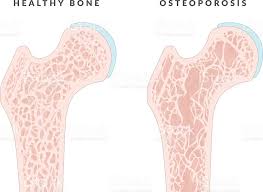
What Is Osteoporosis?
Osteoporosis literally means bone becoming porous. It is called the ‘Silent Thief’ because often there are often no symptoms until a fracture occurs. This disease affects over 2 million Australians. It is estimated that 2 out of 3 women and 1 out of 3 men above the age of 60 will have a fracture as a result of this disease. Bone density decreases as we age. It causes the bone to become more brittle and prone to fracture. The loss of calcium, reduced hormone production, and parathyroid diseases are some of the factors that cause osteoporosis.
Who Gets Osteoporosis?
Our bone density reaches its maximum around the age of 25 and slowly declines after that. Though it mainly affects people over the age of 45, young people who do not reach their maximum bone mass will have a higher risk of osteoporosis in later life.
These are the risk factors of developing osteoporosis:
- Menopause
- Cigarette smoking
- Excessive alcohol
- Excessive caffeine
- Vitamin D deficiency
- Lack of bone building exercise
- Family history of osteoporosis
- Malnutrition
- Some pharmaceutical drugs such as steroids, diuretics, blood thinners, and painkillers
- Diabetes
- Hyperactive thyroid
- Parathyroid diseases
Osteoporosis – Are you in the high-risk category?
Which of the following(s) describes you:
- Caucasian or Asian female (male to a lesser extent)
- Someone in your family has had bone fractures due to aging
- Hormonal decline due to menopause or hysterectomy
- Lack vitamin D and calcium
- Big on animal protein
- Smoke cigarettes or drink alcohol
- Excessive caffeine intake
- Lack exercise and sunlight
- Long term medication such as steroids, painkillers, blood-thinners.
- Chronic illnesses such as disorders of the stomach, kidneys, liver, diabetes, overactive thyroid.
What Does Osteoporosis Feel Like?
Although there are usually no symptoms when osteoporosis first occurs, pain and discomfort can be experienced after a certain amount of bone loss. Here are the main symptoms:
- Pain
- Decreased height
- Humped back
- Fractures
How Is Osteoporosis Treated?
Here is a list of common treatments for osteoporosis:
- Hormone replacement therapy (HRT) for menopausal women
- Bisphosphonates to prevent bone loss
- Chinese herbs
- Vitamin D supplement
- Calcium supplement
- Glucosamine
The pharmaceutical drug options (HRT and bisphosphonates) do carry considerable side effects. Discuss with your therapist and do some research.
Chinese Herbal Remedies That Strengthen Your Bones
According the ancient Chinese medicine theory, bone health is largely related to the Kidney and Spleen systems. The “Kidney system” is in charge of bone, spinal cord, brain, hormones, hair, water metabolism, growth, reproduction and ageing. As we get older, the Kidney energy declines. As a result women’ period stops, our hair turns grey, thin and brittle, our memory declines and our bones thin. The “Spleen system” is in charge of digestion, absorption, fluid metabolism, blood production and circulation. A strong Spleen system means that you have good energy, good appetite, regular bowel movement and strong muscles. A weak “Spleen” means insufficient nutrients and blood are going to the bone cells.
The Kidney and the Spleen work together to manage bone health. Herbs such as Shan Yao 山药,Shu Di 熟地,Dang Shen 党参, Huang Qi 黄芪,Xu Duan 續段,Gou Qi Zi 构杞子, Tu Si Zi 菟蕬子 may be able to manage some of your symptoms. Acupuncture points such as BL 23, KD 3, ST 36 and SP 6 can strengthen the Kidney and Spleen systems.
Tips for Healthy Bones
1 Increase Calcium Intake
Calcium is a major component in bones. You can get this from salmon, dark leafy greens, broccoli, almonds, soy, and dairy products.
2. Increase Magnesium Intake
Magnesium aids the absorption of calcium. It is found in dark green leafy greens, salmon, legumes, soy, tofu, whole grains, seeds, nuts, avocados and dark chocolate.
3. Adequate Vitamin D
Vitamin D also aids the absorption of calcium. Do your exercise in the sun. Check your vitamin D levels. Supplement in winter months.
4. Increase Protein Intake
50% of bones are made up of protein. However, too much animal protein has been linked to the leeching of calcium from bones. Protein should be sourced largely from plant and a small amount from animal products.
5. Increase Omega-3 Intake
This protects against bone loss during ageing. It is found in fatty fish, chia seeds, flaxseeds and walnuts.
6. Reduce Caffeine and Soft Drinks
These things leech calcium out of bones.
7. Weight-Bearing Exercises
High-impact exercise such as walking and push ups stimulates bone growth. Tai Chi and Qi Gong improve circulation and stability to prevent falls.


